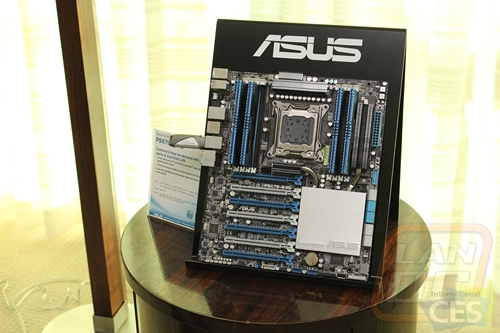
Written by: Adam
Pictures by: Wes
One of the newer markets Asus will develop further into 2013 is storage. While not completely new to the category, this Raidr Express is a ROG branded SSD PCI Express expansion card. JJ, our exhibit guide at the time, says the interest in the card-based SSD storage came from positive feedback from the community about the Republic of Gamers line of existing expansion cards: video, audio, etc. Instead of developing in a market that’s very saturated, the barebone solid-state drive, Asus wanted to provide more options from enthusiasts that wanted faster speeds than SATA. An entire team has been created to develop exclusively for the Raidr series to make sure it doesn’t suffer from many of the problems other PCIe SSD cards see, and they recognize that the ROG brand carries a very high expectation.

Sharing case space with the Raidr was the ARES II, a very large graphics card, but still only a two slot cooling design. This is a full 7970 Ghz card with no downclocking from design or from power issues, which the ARES will not suffer from. It will be launching very shortly, but will be in a limited production of 1,000 units, each laser etched with serial number and a collective commemorative case.


Next up we saw some refreshes to Asus’s motherboards, such as the E35/45 Bravo boards, which will see upgrades to the processor for faster clock speeds and WiFi increased to dual-band. JJ told us that he was able to play games like Awesomenauts, one of our favorites, at 2560x1440, and many other titles in full HD.

990FX series boards will also see an update, such as seeing support for PCI 3.0 lanes even when using the latest generation FX processors from AMD. Some of the heatsink designs have also been redesigned.

If you consider Asus’s product families, from motherboards to networking and beyond, you’ll notice they try to keep a variety of products that offer something to several interest groups: general use, gaming enthusiast, creative prosumer, etc. Monitors are no different, as we witnessed with the company’s new models. The first are crafted for the gamers, featuring the higher refresh rates generally associated with 3D monitors without the 3D requirement.
If you’re a fan of competitive gaming, you may recall that Asus was the official monitor of IPL5. The VG248QE continues to cater to the pro gaming crowd, especially strategy games like League of Legends and Starcraft II by including tools right on the monitor allowing the player to create custom timers right on the screen itself. These could be used to time Baron countdown, or track build order status in real time. For the more first-person orientated, similar technology allows the creation of a crosshair on the screen, to help with accuracy.

The displays used to show off the motherboards are actually new products as well, focused on the creative or prosumer crowds. The two models essentially cater to user that may way tall or wide screens, and also use features similar to the VG series that will display common frames used in media creation, such as 4x6, right on the screen.


We known fans of the Transformer line from Asus, and we were excited to see the AiO P1801. The model number, by the way, denotes the 18” tablet. This looks like a typical monitor, even using a full version of Windows 8. However, the tablet can be removed from the base from behind via a handle near the top, which is also sturdy enough to carry it to and from. The P1801 actually dual-boots, so Andriod OS and Windows run simultaneously and can be switched on demand. Though at the time of show undocking the tablet forced it to Android (Windows continues to run on the base), they are working on continuing the session of Windows remotely until the user wants to switch over.




We were tricked again by the MB168B, assuming it was a tablet but in actuality is a USB-powered monitor that is extremely light weight. Running through a USB3.0 connection, the 168B is capable of 1366x768 resolution and a response time of 10ms.


Nick took us over to a neighboring suite where Asus was demonstrating their latest offerings in networking. Many models are seeing upgrades to the AC standard, which is no surprise given the emerging technology. Included is the PCE-AC66, a beefy PCIe 3x3 wireless adapter to allow for the speeds of AC.



The WL-330NUL is an All-in-One USB adapter that we definitely could’ve put to use in our makeshift office. This is not only a wireless adapter, but also a router that can rebroadcast an SSID.

Asus also showed off a dual band range extender that could rebroadcast 2.4Ghz to 5Ghz, as well as an AC update to the wireless USB adapter.




